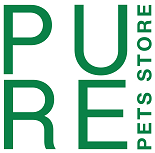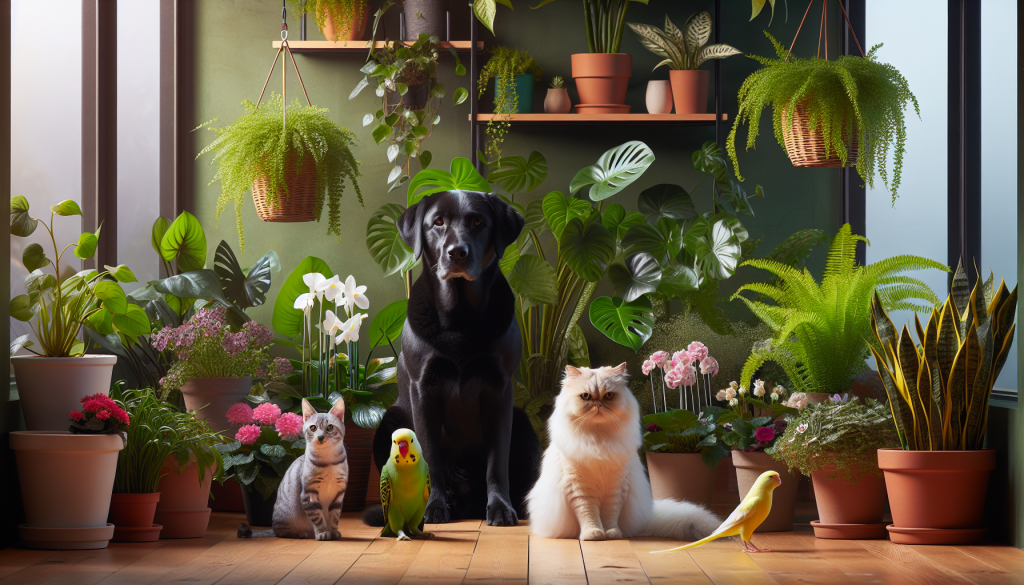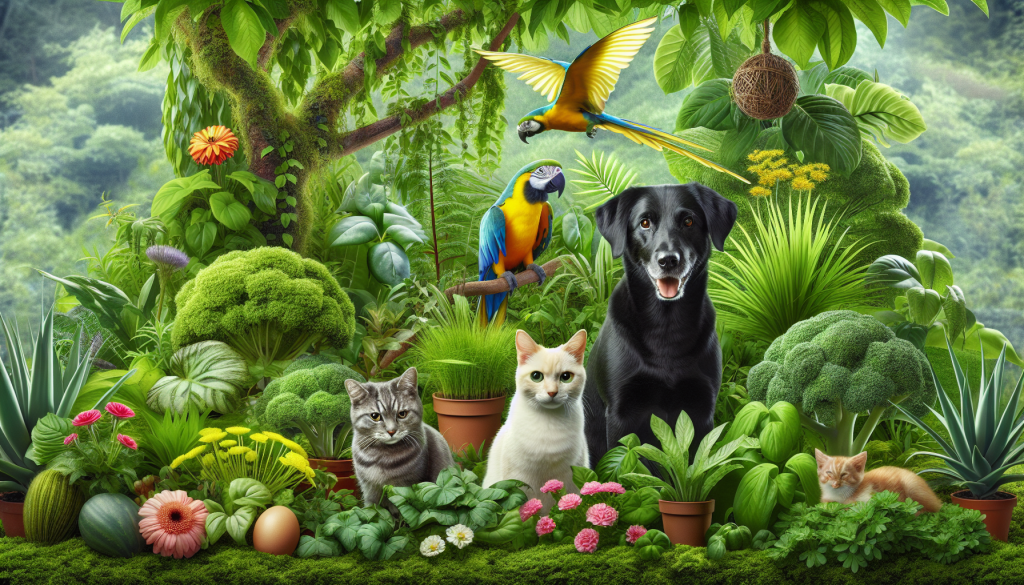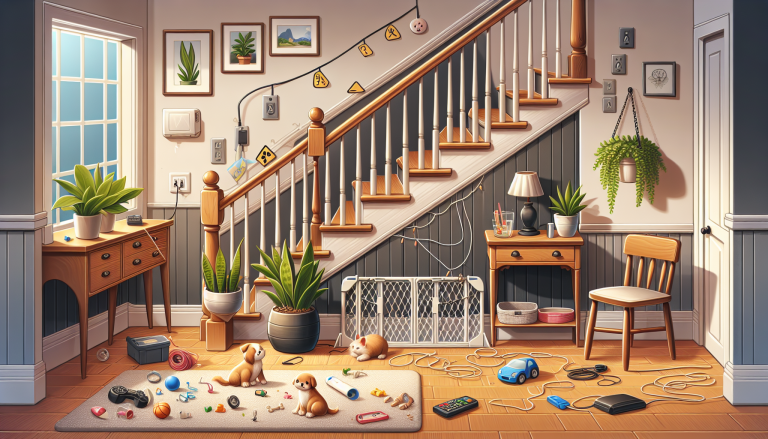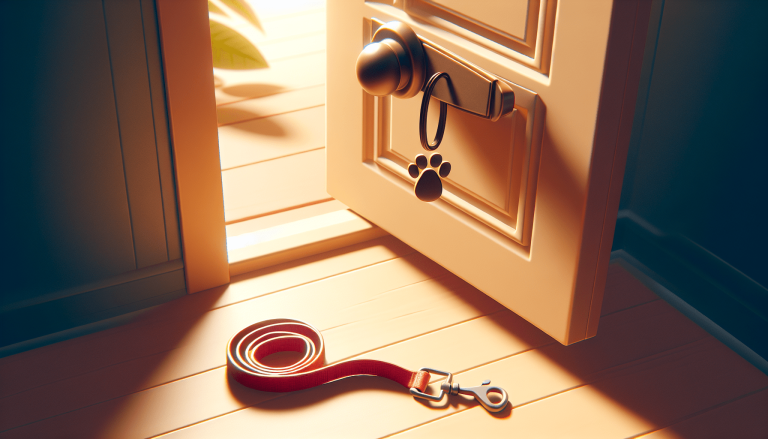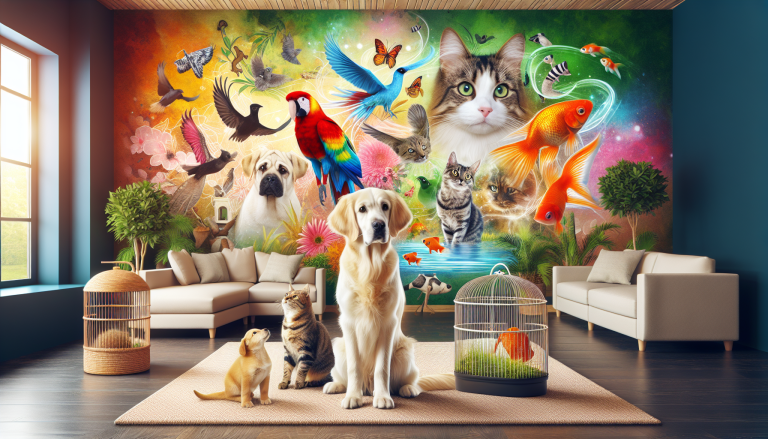Are you a proud pet owner who also loves plants and flowers? If so, then you have come to the right place! In this ultimate guide, we will explore the wonderful world of pet-friendly plants and flowers, delving into the types and varieties that are safe for your furry friends to be around. From vibrant blooms to lush green foliage, you will discover a wide range of pet-friendly options that will not only beautify your home but also ensure the safety and well-being of your beloved pets. So, let’s embark on this delightful journey and create a pet-friendly oasis that both you and your furry friends will enjoy!
Table of Contents
ToggleChoosing Pet-Friendly Plants
When it comes to choosing plants for your home or garden, it’s important to consider the needs and safety of your furry friends. Pets, such as cats and dogs, can be curious and may chew or ingest plants that are toxic to them. To create a pet-friendly environment, there are several factors you should consider.
Consider Your Pet’s Behavior
Different pets have different behaviors and tendencies. Some pets may be more inclined to chew on plants, while others may simply ignore them. Take some time to observe your pet’s behavior around plants before making any decisions. If you notice that your pet shows a strong interest in plants or tends to chew on them, it’s important to choose plants that are safe for them.
Research Toxicity
Before bringing any plants into your home or garden, it’s crucial to research their toxicity levels. Some plants can be extremely toxic to pets and can cause severe health issues if ingested. Familiarize yourself with the list of common toxic plants and make sure to avoid them. It’s always better to be safe than sorry when it comes to the well-being of your pets.
Avoid Plants with Thorns or Spines
Plants with thorns or spines can pose a risk of injury to your pets. When selecting pet-friendly plants, it’s best to opt for plants without any sharp edges. This will help minimize the risk of your pets getting injured while exploring their surroundings. Stick to plants that have smooth leaves or flowers to ensure the safety of your furry friends.
Select Plants Safe for Cats
If you have a feline friend, it’s important to choose plants that are safe for cats. Cats are known to be curious climbers and may be more susceptible to nibbling on plants. Avoid plants that are toxic to cats, such as lilies, tulips, and sago palms. Instead, opt for pet-safe plants such as spider plants, African violets, and catnip.
Select Plants Safe for Dogs
Dogs can also be prone to investigating plants and may chew on them out of curiosity. To ensure your dog’s safety, choose plants that are non-toxic to dogs. Avoid plants like azaleas, hydrangeas, and daffodils, which can cause harm if ingested. Instead, consider pet-friendly options like sunflowers, marigolds, and rosemary for your outdoor space.
Choose Non-Toxic Flowers
If you like to have flowers in your home or garden, it’s essential to select non-toxic varieties. Flowers are a beautiful addition to any space, but some can be harmful to pets if ingested. Choose flowers such as zinnias, cosmos, and petunias, which are safe for both cats and dogs. By opting for non-toxic flowers, you can enjoy their beauty without worrying about your pets’ safety.
Consider the Size and Space
When choosing pet-friendly plants, it’s crucial to consider the size and space available to you. Some plants can grow quite large and may not be suitable for smaller spaces. Ensure that the plants you choose can thrive in the environment you provide for them. Additionally, consider the size of your pets and how they may interact with the plants. Smaller plants may be easier to manage and less tempting for pets to explore.
Select Easy to Maintain Plants
If you’re not the most experienced gardener or simply don’t have much time to dedicate to plant care, it’s important to choose plants that are easy to maintain. Some plants require more attention and care than others. Look for plants that are known for their resilience and adaptability. This will help ensure that your pet-friendly plants thrive with minimal effort on your part.
Consider Allergies and Sensitivities
Just like humans, pets can also have allergies or sensitivities to certain plants. Some pets may have a reaction to pollen or certain plant odors. Take note of any allergies or sensitivities your pet may have and choose plants accordingly. If your pet is prone to allergies, opt for plants with minimal pollen production or choose plants that do not have a strong scent.
Choose Plants that are Pet-Safe and Aesthetically Pleasing
Finding a balance between pet safety and aesthetics is key when selecting pet-friendly plants. You want your home or garden to look beautiful, but not at the expense of your pets’ well-being. Luckily, there are numerous plants available that are both pet-safe and visually appealing. Take your time to research and choose plants that will enhance your space while keeping your furry friends safe.
Pet-Friendly Indoor Plants
Indoor plants can bring life and beauty to your home while providing cleaner air and a relaxing atmosphere. If you have pets, it’s important to choose indoor plants that are safe for them. Here are some pet-friendly indoor plants to consider:
Spider Plant
Spider plants are known for their air-purifying qualities and are safe for both cats and dogs. They have long, arching leaves with variegated patterns, making them an attractive addition to any indoor space. Spider plants are easy to care for and can withstand a variety of conditions, making them a popular choice for pet owners.
Boston Fern
Boston ferns are not only a pet-safe choice but also add a touch of elegance to any room. These ferns have feathery, delicate fronds that create a lush green display. Boston ferns thrive in indirect light and require high humidity, making them ideal for bathrooms or kitchens. Keep in mind that ferns may require a bit more maintenance, such as regular misting to maintain their humidity needs.
Areca Palm
Areca palms are not only safe for pets but also serve as excellent natural air purifiers. These palms feature feathery, arching fronds and can create a tropical ambiance in any room. Areca palms thrive in bright, indirect light and require regular watering. They can grow quite tall, so make sure you have enough space for their growth.
African Violet
African violets are compact, flowering plants that add a pop of color to any indoor setting. They come in various shades, including purple, pink, blue, and white. African violets are safe for both cats and dogs and require moderate light and humidity. With proper care and attention, they can bloom all year round.
Bamboo Palm
Bamboo palms, also known as the reed palm, are safe for pets and can thrive indoors. These palms have slender, bamboo-like stems with lush, green foliage. Bamboo palms are known for their resilience and can tolerate lower light levels, making them suitable for various indoor environments. They require regular watering and can benefit from occasional misting to maintain humidity.
Money Tree
Money trees, also known as Pachira aquatica, are considered a symbol of good luck and prosperity. These small, tree-like plants have thick, braided stems and palmate leaves. Money trees are safe for both cats and dogs and thrive in bright, indirect light. They require regular watering and well-draining soil to prevent root rot.
Prayer Plant
Prayer plants, also known as Maranta leuconeura, are pet-safe indoor plants named for their unique leaf movement. Their leaves lie flat during the day and fold upward in the evening, resembling hands in prayer. Prayer plants prefer bright, indirect light and require regular watering to maintain their humidity needs. They add a touch of elegance and interest to any indoor space.
Phalaenopsis Orchid
Phalaenopsis orchids, commonly known as moth orchids, are safe for pets and can make a stunning statement in any indoor setting. These orchids have long-lasting, exotic blooms that come in various colors, such as white, pink, and purple. Phalaenopsis orchids prefer bright, indirect light and require proper watering and humidity to thrive.
Ponytail Palm
Ponytail palms, also known as Beaucarnea recurvata, are unique indoor plants with a distinctive look. They have a swollen, bottle-shaped base that stores water, making them quite resilient to neglect. Ponytail palms are safe for pets and thrive in bright, indirect light. They require infrequent watering and are known for their easy maintenance.
Christmas Cactus
Christmas cacti are popular indoor plants that bloom around the winter holidays, adding a touch of festive cheer to your home. These cacti are safe for pets and have segmented, flat stems that produce colorful flowers. Christmas cacti prefer bright, indirect light and require regular watering during their growth period. With proper care, they can bloom year after year.
Pet-Friendly Outdoor Plants
Creating a pet-friendly outdoor space allows your furry friends to enjoy the fresh air while being surrounded by safe and beautiful plants. Here are some pet-friendly outdoor plants to consider:
Sunflowers
Sunflowers are not only a vibrant and cheerful addition to any garden but also safe for pets. These tall, bright flowers can bring a sense of joy and beauty to your outdoor space. Sunflowers thrive in full sun and well-draining soil, making them a popular choice for garden enthusiasts.
Marigolds
Marigolds are easy-to-grow flowers that come in a variety of vibrant colors, such as orange, yellow, and red. These cheerful flowers are safe for pets and can help repel certain pests from your garden. Marigolds thrive in full sun and require well-draining soil.
Coneflowers
Coneflowers, also known as Echinacea, are hardy and low-maintenance flowers that attract bees and butterflies. These beautiful flowers come in various colors, including pink, purple, and white. Coneflowers are safe for pets and can thrive in full sun or partial shade, making them a versatile choice for any garden.
Snapdragons
Snapdragons are tall, spiky flowers known for their unique shape and vibrant colors. These flowers are safe for pets and can add a vertical element to your garden. Snapdragons prefer full sun and require regular watering to thrive.
Zinnias
Zinnias are cheerful, daisy-like flowers that come in a wide range of colors, from bold and bright to soft and pastel. These flowers are safe for pets and can attract butterflies to your garden. Zinnias thrive in full sun and require regular watering to flourish.
Cosmos
Cosmos flowers are delicate and daisy-like, creating a beautiful display of color in any garden. These flowers are safe for pets and can tolerate various soil conditions. Cosmos thrive in full sun and require minimal maintenance, making them a popular choice for pet-friendly gardens.
Petunias
Petunias are versatile flowers that come in various colors and can be grown in containers, hanging baskets, or flower beds. These hardy flowers are safe for pets and can withstand hot summers and intense sunlight. Petunias require regular watering and benefit from occasional deadheading to promote continuous blooming.
Hibiscus
Hibiscus flowers are known for their vibrant, trumpet-shaped blooms that can add a tropical touch to your outdoor space. These flowers are safe for pets and can thrive in full sun or partial shade. Hibiscus plants require regular watering and can benefit from occasional fertilization to encourage healthy growth.
Rosemary
Rosemary is a fragrant herb that not only adds flavor to your dishes but also serves as a pet-friendly outdoor plant. Rosemary plants have needle-like leaves and small blooms that can attract bees and other beneficial pollinators. These plants thrive in full sun and well-draining soil and are known for their resilience.
Catnip
Catnip is a well-known herb that has a stimulating effect on cats. If you have feline friends, growing catnip in your outdoor space can provide them with a source of entertainment. Catnip plants have attractive, heart-shaped leaves and small clusters of white or lavender flowers. They thrive in full sun and well-draining soil.
Pet-Friendly Herbs
Growing your own herbs not only allows you to enhance your culinary creations but also provides a pet-friendly option for your garden. Here are some herbs that are safe for pets:
Basil
Basil is an aromatic herb widely used in cooking and adds a delightful scent to your garden. This herb is safe for pets and can be easily grown in containers or garden beds. Basil plants thrive in full sun and require regular watering.
Parsley
Parsley is a versatile herb that can be used as a garnish or in various dishes. This herb is safe for pets and can be grown in containers or in the ground. Parsley plants prefer partial shade and require regular watering to thrive.
Mint
Mint is a fragrant herb that can add a refreshing touch to drinks, desserts, or savory dishes. Various mint varieties, such as spearmint and peppermint, are safe for pets. Mint plants can be invasive, so consider growing them in containers to prevent them from spreading throughout your garden. Mint plants thrive in partial shade and require regular watering.
Thyme
Thyme is a versatile herb with a strong, aromatic flavor that can enhance a variety of dishes. This herb is safe for pets and can be grown in containers or directly in the ground. Thyme plants thrive in full sun and require well-draining soil.
Dill
Dill is an herb commonly used in pickling and pairs well with fish and vegetable dishes. This herb is safe for pets and can be grown in containers or garden beds. Dill plants thrive in full sun and require regular watering.
Rosemary
Rosemary, as mentioned earlier, is not only a pet-friendly outdoor plant but also a versatile herb. Growing rosemary in containers or your garden will provide a fresh supply of this fragrant herb that can be used in various culinary creations. Rosemary plants thrive in full sun and well-draining soil.
Sage
Sage is an herb with a distinct flavor that can add depth to a variety of dishes. This herb is safe for pets and can be grown in containers or garden beds. Sage plants prefer full sun and well-draining soil.
Oregano
Oregano is a pungent herb commonly used in Italian and Mediterranean cuisines. This herb is safe for pets and can be grown in containers or directly in the ground. Oregano plants thrive in full sun and require well-draining soil.
Cilantro
Cilantro, also known as coriander, has a unique flavor that is popular in Mexican, Indian, and Asian dishes. This herb is safe for pets and can be grown in containers or garden beds. Cilantro plants prefer partial shade and require regular watering.
Chamomile
Chamomile is an herb known for its calming properties and is commonly used to make herbal teas. This herb is safe for pets and can be grown in containers or garden beds. Chamomile plants thrive in full sun to partial shade and require regular watering.
Identifying and Avoiding Toxic Plants
While it’s important to know which plants are safe for your pets, it’s equally crucial to be aware of the plants that are toxic to them. Here are some common toxic plants to avoid:
Lilies
Lilies, especially those from the Lilium or Hemerocallis genus, are highly toxic to cats. Ingesting any part of the plant, including the leaves, stems, petals, or even the water from a vase containing lilies, can cause severe kidney damage or even be fatal. It’s best to avoid having lilies in your home or garden if you have cats.
Tulips
Tulips contain toxins that can cause gastrointestinal upset and irritation if ingested by pets. These spring-blooming flowers can be harmful to both cats and dogs. It’s essential to keep tulips out of reach and avoid planting them in areas accessible to your pets.
Sago Palm
Sago palms, also known as Cycas revoluta, are highly toxic to pets, especially dogs. All parts of the plant, including the seeds, foliage, and roots, contain toxins that can cause severe liver damage. Ingestion of sago palm can be life-threatening for pets, so it’s crucial to avoid planting them in your garden or having them indoors.
Azaleas
Azaleas are beautiful flowering shrubs, but they contain toxins that can be harmful to pets. Ingestion of azalea leaves, flowers, or stems can lead to symptoms such as vomiting, diarrhea, and even cardiovascular issues in severe cases. It’s best to choose pet-safe alternatives and avoid planting azaleas in your outdoor space.
Hydrangeas
Hydrangeas are popular flowering shrubs known for their colorful blooms. However, certain varieties of hydrangeas, such as the mophead or lacecap hydrangeas, contain toxins that can cause gastrointestinal upset and other symptoms if ingested by pets. It’s important to choose pet-friendly alternatives and be cautious if you have hydrangeas in your garden.
Daffodils
Daffodils are vibrant spring flowers that add a burst of color to gardens. While they are safe for humans, all parts of the daffodil plant, especially the bulbs, are toxic to pets. Ingesting daffodils can cause gastrointestinal upset, drooling, and other symptoms in dogs and cats. It’s best to avoid having daffodils in areas accessible to your pets.
Hostas
Hostas are popular shade-loving plants known for their attractive foliage. While they are not highly toxic, the leaves of hostas can cause gastrointestinal upset if ingested by pets. It’s important to monitor your pets and discourage them from nibbling on hosta leaves to prevent any potential issues.
Oleander
Oleander is a highly toxic plant that can be lethal if ingested by pets. All parts of the oleander plant, including the leaves, flowers, and even the water from a vase containing oleanders, contain cardiac glycosides, which can cause severe cardiovascular issues in pets. It’s crucial to avoid having oleanders in your garden or anywhere accessible to your pets.
Aloe Vera
Aloe vera is often praised for its medicinal properties and skin-soothing effects. However, the gel extracted from the leaves of aloe vera plants can be toxic to pets if ingested in large quantities. It’s best to keep aloe vera plants out of reach of your pets to prevent any potential issues.
Cycad Palms
Cycad palms, similar to sago palms, contain toxins that can be harmful to pets. All parts of the plant, including the leaves and seeds, can cause severe gastrointestinal issues and liver damage if ingested by pets. It’s important to avoid planting cycad palms in your garden if you have pets.
Creating a Safe Space for Pets
Ensuring a pet-friendly environment involves more than just choosing the right plants. Here are some tips for creating a safe space for your pets:
Keep Plants Out of Reach
To prevent your pets from accessing plants that may pose a risk, it’s important to keep them out of reach. Place indoor plants on shelves, stands, or hanging baskets where your pets cannot reach them. For outdoor plants, consider using raised planters or fencing to keep pets away.
Consider Elevated Planters
Elevated planters, such as raised garden beds or hanging planters, can help protect your plants from curious pets. These planters can be installed at a height that is out of reach for your pets, reducing the chances of them chewing on or digging around your plants.
Use Hanging Baskets
Hanging baskets are a great way to add greenery to your indoor or outdoor space while keeping plants safely away from pets. Hang baskets from ceilings or hooks where pets cannot access them. This not only ensures the safety of your pets but also adds a decorative element to your space.
Create Barriers or Fencing
If you have certain areas of your garden that you want to keep off-limits to your pets, consider installing barriers or fencing. This can help create designated pet-free zones where you can grow plants that may not be safe for pets. Ensure that the barriers or fencing are secure and tall enough to prevent your pets from jumping over or digging under them.
Closely Monitor Indoor Plants
While you may take precautions to keep plants out of reach, it’s important to closely monitor your pets’ interactions with indoor plants. Some pets may be more persistent or resourceful than others. Keep an eye on your pets and discourage any behavior that may be harmful to them or your plants.
Know the Signs of Plant Poisoning
It’s essential to be familiar with the signs of plant poisoning in pets. Common symptoms may include excessive drooling, vomiting, diarrhea, loss of appetite, lethargy, skin irritation, difficulty breathing, changes in urination, abnormal behavior, seizures, or even coma. If you notice any unusual behavior or symptoms in your pets, consult your veterinarian immediately.
Consult a Veterinarian if Needed
If you suspect that your pet has ingested a toxic plant or is experiencing symptoms of plant poisoning, it’s crucial to seek veterinary assistance immediately. Veterinarians can provide the necessary guidance and treatment to help your pet recover from plant poisoning.
Establish a Designated Pet Area
Creating a designated pet area in your garden can help ensure the safety of your pets while allowing them to enjoy the outdoors. Set up a secure, fenced area where your pets can roam freely without the risk of them getting into plants that may be harmful to them.
Provide Pet-Friendly Alternatives
Offering pet-friendly alternatives can help redirect your pets’ attention from potentially harmful plants. Provide toys, scratching posts, or designated areas for your pets to explore and play. This can help satisfy their natural instincts while keeping them away from plants that may cause harm.
Regularly Clean and Maintain Plants
Regularly cleaning and maintaining your plants is important for both their health and the safety of your pets. Remove any fallen leaves, flowers, or other plant debris that may be tempting for your pets to chew on. Keep plants clean and free from pests or diseases that could pose a risk to your pets.
Outdoor Planting Tips
When planning your outdoor garden, consider these tips to create a safe and enjoyable space for both your pets and your plants:
Prepare the Garden
Before planting, prepare your garden by removing any potentially harmful plants or toxic weeds. Clear the area of debris or objects that could pose a risk to your pets. Make sure the soil is well-prepared and amended to support healthy plant growth.
Be Mindful of Mulch
Choose pet-safe mulch options in your garden. Some types of mulch, such as cocoa mulch, can be toxic to pets if ingested. Opt for natural mulch materials like wood chips or straw to promote a safe and pet-friendly environment.
Avoid Harmful Pesticides
When tending to your garden, avoid using harmful pesticides or chemical fertilizers that can be toxic to pets. Opt for pet-safe alternatives or natural pest control methods to keep your garden free from pests while ensuring your pets’ safety.
Create a Digging Spot
If your pets enjoy digging, provide them with a designated digging spot in your garden. This can help redirect their digging behavior away from your plants. Fill the digging area with soft soil or sand and encourage your pets to use it by burying toys or treats.
Grow Pet-Friendly Grass
If you have a lawn and pets, consider growing pet-friendly grass varieties. Some types of grass, such as Bermuda grass or Kentucky bluegrass, can be harmful if ingested by pets. Research and choose grass varieties that are safe for pets, such as fescue or perennial ryegrass, to promote a safe outdoor environment.
Create Pathways
Install pathways or walkways in your garden to guide both you and your pets around the space. Pathways can help prevent accidental trampling or damage to plants and provide a clear route for your pets to navigate without disturbing sensitive areas.
Use Natural Repellents
To keep pests away from your garden without harming your pets, consider using natural repellents. Planting herbs like citronella, lavender, or lemongrass can help deter insects, while certain flowers like marigolds can repel pests such as mosquitoes and aphids.
Consider Fencing Options
If you have specific areas of your garden that you want to keep off-limits to your pets, consider installing fencing. Choose pet-friendly fencing materials and ensure that the fencing is securely installed to prevent your pets from accessing restricted areas.
Install Pet-Safe Water Features
Water features, such as ponds or fountains, can add a calming element to your garden. When incorporating water features, ensure they are designed with pet safety in mind. Consider shallow areas or provide ramps for easy access and exit. Always supervise your pets around water features to prevent accidents.
Remove Toxic Weeds
Regularly inspect your garden for any toxic weeds that may pose a risk to your pets. Common toxic weeds include foxglove, morning glory, and pokeweed. It’s important to remove these weeds promptly to prevent accidental ingestion by your pets.
Common Signs of Plant Poisoning in Pets
It’s important to be aware of the common signs of plant poisoning in pets. If you notice any of the following symptoms, contact your veterinarian immediately:
Excessive Drooling
Pets experiencing plant poisoning may exhibit excessive drooling or foaming at the mouth. This could indicate irritation or discomfort in their oral cavity.
Vomiting or Diarrhea
Vomiting and diarrhea are common signs of plant poisoning in pets. If your pet suddenly vomits or has loose stools, it could be an indication of ingesting a toxic plant.
Loss of Appetite
A sudden loss of appetite can be a symptom of plant poisoning. If your pet refuses to eat or shows a decreased interest in food, it’s important to monitor their behavior and seek veterinary advice if necessary.
Lethargy or Weakness
Experiencing plant poisoning can cause pets to become lethargic or weak. They may lack energy, seem drowsy, or have difficulty moving. If you notice a significant decrease in your pet’s activity level, it may be a cause for concern.
Skin Irritation
Contact with certain plants can cause skin irritation in pets. If you notice redness, swelling, or itching on your pet’s skin, it may be a reaction to a toxic plant. Consult your veterinarian for appropriate treatment.
Difficulty Breathing
Ingesting or coming into contact with certain plants can cause respiratory issues in pets. If your pet is struggling to breathe, wheezing, or coughing, it may be an emergency situation. Seek immediate veterinary assistance.
Changes in Urination
Plant poisoning can affect pets’ urinary system, leading to changes in urination. Increased frequency, difficulty urinating, or blood in the urine may indicate plant poisoning. Consult your veterinarian if you notice any unusual changes in your pet’s urination.
Abnormal Behavior
Some pets may exhibit abnormal behavior as a result of plant poisoning. This can include restlessness, pacing, aggression, or disorientation. Monitor your pet closely and seek veterinary advice if their behavior seems concerning.
Seizures
In severe cases of plant poisoning, pets may experience seizures. Seizures can manifest as involuntary movements, convulsions, or loss of consciousness. If your pet has a seizure, it is a medical emergency, and immediate veterinary attention is required.
Coma
In rare and severe cases, plant poisoning can lead to a coma. If your pet becomes unresponsive, unconscious, or shows a lack of normal reflexes, it is a life-threatening situation. Seek emergency veterinary care immediately.
First Aid for Plant Poisoning
If you suspect that your pet has ingested a toxic plant, it’s important to take immediate action while awaiting veterinary assistance. Here are some first aid steps to follow:
Remove the Plant from the Area
If you catch your pet in the act of ingesting a toxic plant, carefully remove the plant from their mouth or paws. Be cautious not to expose yourself to any harmful substances.
Call a Veterinarian Immediately
Contact your veterinarian or a local emergency veterinary clinic immediately to seek advice and inform them of the situation. They can provide specific guidance based on the plant ingested and the symptoms your pet is experiencing.
Identify the Plant
If possible, try to identify the plant that your pet has ingested. Take a sample or photograph of the plant to aid in accurate diagnosis and treatment. This information will be valuable for your veterinarian’s assessment.
Offer Your Pet Water
If your pet is still conscious and able to drink, offer them fresh water to help dilute any potential toxins and flush them out of their system. Ensure the water is readily available but do not force your pet to drink if they are unwilling.
Avoid Inducing Vomiting
Do not attempt to induce vomiting in your pet without specific instructions from a veterinarian. Some plants can cause more harm if they are brought back up, and vomiting may not be safe or appropriate in every situation.
Seek Veterinary Treatment
Even if your pet appears to recover or their symptoms seem to subside, it’s crucial to seek veterinary treatment to ensure their safety. Some plant toxins may have delayed or long-lasting effects, and it’s best to have your pet evaluated by a professional.
Follow Veterinarian’s Instructions
Once you have sought veterinary treatment, follow your veterinarian’s instructions carefully. They may recommend additional diagnostic tests, administer specific treatments, or advise on how to monitor your pet’s condition at home. Compliance with their guidance is crucial for your pet’s recovery.
Monitor and Provide Comfort
Monitor your pet closely during their recovery period and provide comfort as needed. Keep them in a calm and quiet environment, and observe any changes in their behavior or symptoms. Report any concerns to your veterinarian promptly.
Prevent Future Incidents
Take steps to prevent future incidents of plant poisoning. Remove or replace any toxic plants in your home or garden. Keep an eye on your pets to ensure they do not access restricted areas or potentially harmful plants.
Educate Yourself on Emergency Measures
Educate yourself on emergency measures for pet poisoning and have important phone numbers, such as those of your veterinarian or local emergency clinics, readily available. Being prepared can help you act swiftly and appropriately in case of emergencies.
Conclusion
Creating a pet-friendly environment involves careful consideration of the plants and flowers you choose for your home and garden. By selecting pet-safe options, you can enjoy the beauty of plants while promoting a safe space for your furry friends. Remember to research toxicity levels, avoid plants with thorns or spines, and choose plants that are safe for your specific pets. Establishing a safe space, closely monitoring your plants and pets, and being aware of the signs of plant poisoning are essential for responsible pet ownership. By following these guidelines, you can create a harmonious balance between pets and plants, enhancing your home and garden with pet-friendly choices.
